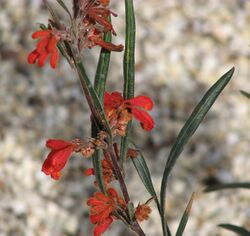Biology:Grevillea bronweniae
| Grevillea bronweniae | |
|---|---|

| |
| In Maranoa Gardens | |
| Scientific classification | |
| Kingdom: | Plantae |
| Clade: | Tracheophytes |
| Clade: | Angiosperms |
| Clade: | Eudicots |
| Order: | Proteales |
| Family: | Proteaceae |
| Genus: | Grevillea |
| Species: | G. bronweniae
|
| Binomial name | |
| Grevillea bronweniae Keighery[1]
| |
Grevillea bronweniae is a species of flowering plant in the family Proteaceae and is endemic to the south-west of Western Australia. It is an erect shrub usually with more or less linear leaves, and wheel-like clusters of crimson flowers.
Description
Grevillea bronweniae is an erect shrub that typically grows to a height of 1.0 to 1.8 metres (3.3 to 5.9 ft). The leaves are linear to narrowly elliptic with the narrower end towards the base, 10 to 160 millimetres (0.4 to 6.3 in) long and 2 to 14 millimetres (0.08 to 0.55 in) wide with the edges curved down or rolled under. The flowers are arranged in wheel-like clusters in leaf axils and at the ends of stems, on a rachis 0.5–2.0 mm (0.020–0.079 in) long, and are scarlet. The pistil is 8–12 mm (0.31–0.47 in) long and hairy. Flowering occurs from June to November and the fruit is a woolly-hairy, narrow oval follicle about 15 mm (0.59 in) long.[2][3][4]
Taxonomy
Grevillea bronweniae was first formally described by botanist Gregory John Keighery in Nuytsia in 1990.[4][5] The specific epithet (bronweniae) honours Keighery's wife and botanist, Bronwen Keighery.[5]
The FloraBase of the Western Australian Herbarium gives this taxon the name Grevillea bronwenae.[2]
Distribution and habitat
This grevillea grows in low woodland between Nannup and Busselton in the Jarrah Forest and Swan Coastal Plain biogeographic regions of south-western Western Australia.[2][4]
Conservation status
Grevillea bronweniae is listed as "Priority Three" by the Government of Western Australia Department of Biodiversity, Conservation and Attractions,[2] meaning that it is poorly known and known from only a few locations but is not under imminent threat.[6]
References
- ↑ "Grevillea bronweniae". Australian Plant Census. https://biodiversity.org.au/nsl/services/apc-format/display/117936.
- ↑ 2.0 2.1 2.2 2.3 "Grevillea bronwenae". FloraBase. Western Australian Government Department of Parks and Wildlife. https://florabase.dpaw.wa.gov.au/browse/profile/12219.
- ↑ "Grevillea bronwenae". Australian Biological Resources Study, Department of Agriculture, Water and the Environment: Canberra. https://profiles.ala.org.au/opus/foa/profile/Grevillea%20bronwenae.
- ↑ 4.0 4.1 4.2 Keighery, Gregory J. (1990). "Taxonomy of the Grevillea brachystylis species complex (Proteaceae)". Nuytsia 7 (2): 128–131. https://www.biodiversitylibrary.org/item/233144#page/18/mode/1up. Retrieved 29 October 2021.
- ↑ 5.0 5.1 "Grevillea bronweniae". APNI. https://id.biodiversity.org.au/instance/apni/552178.
- ↑ "Conservation codes for Western Australian Flora and Fauna". Government of Western Australia Department of Parks and Wildlife. https://www.dpaw.wa.gov.au/images/documents/plants-animals/threatened-species/Listings/Conservation%20code%20definitions.pdf. Retrieved 29 January 2022.
Wikidata ☰ Q8965088 entry
 |


